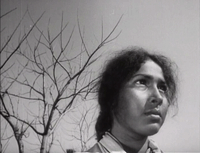A River Called Titas opens to the eerily desolate yet tranquil sight of a receded river basin as the expressive voice of a traditional folk singer (Dheeraj Uddin Fakir) serenades the mighty Titas River in East Bengal with a soulful ode on the river’s inconstant ebb and flow that manifests its alternately fickle grace, mercy, and wrath towards the local villagers who rely on the river for their humble commerce and survival. At a fishing village near the riverbank, a girl named Basanti prepares for the Maghmandal ritual to commemorate the coming of winter and her passage to maturity as two friends, Kishore and Subol compete for her affection by building a leaf boat in her honor before joining an uncle to embark on their first extended fishing expedition to the village of Ujaninajar. However, fate invariably intercedes when, years later, Kishore (Prabir Mitra), while staying at a distant village to fish, rescues a beautiful young woman named Rajar Jhi (Kabari Choudhury) during a tribal scuffle. Persuaded by a local fisherman to return to the village to meet the tribal elder in order to foster closer economic and social ties between their communities, Kishore soon realizes that the town’s implication of a “binding gift” is an arranged marriage to Rajar Jhi. It is a union that proves to be short-lived when bandits board their boat en route home, and a distraught and inconsolable Kishore becomes mad with grief. Inevitably, the villagers’ inalterable pattern of austerity, despair, and tragedy emerges as the star-crossed Basanti (Rosy Samad), abandoned by her childhood love, is married off to Kishore’s romantic rival Subol, who too is soon lost to the silent, unforgiving waters.
Adapted from the Bengali novel by Advaita Malo Barman, A River Called Titas is a thoughtful, sincere, and bittersweet chronicle of poverty, obsolescence, cultural identity and erasure. Ritwik Ghatak characteristically integrates visual economy, stylized camerawork, and idiosyncratic lyricism through allusive, traditional folk songs, cyclical environmental (and existential) phenomena, and exaggerated natural rhythms and diegetic sounds that illustrate the inherent correlation between landscape and human ritual (fishing activity, tribal customs, and ceremonial festivals). Moreover, through the childless young widow Basanti, Ghatak parallels the increasing barrenness of the environment – a devastating local catastrophe that is further exacerbated by ongoing petty (and often socially motivated) self-interest and fractured relationships within the community that contribute to the inevitable dissolution of the village – with the seemingly inevitable cultural extinction of the Bengali people as a result of the Partition of Bengal between British India and Pakistan in 1947. (Note the similarity to the emotionally abandoned, self-sacrificing heroine Nita, a displaced Bengali refugee, in Ghatak’s earlier film, The Cloud-Capped Star.) By presenting the trauma and desolation of unnatural crisis and division, the film serves as a passionate and haunting elegy for a dying culture, and a native son’s irreconcilable personal chronicle of loss, melancholy, and resigned, inarticulable rage.
© Acquarello 2004. All rights reserved.
